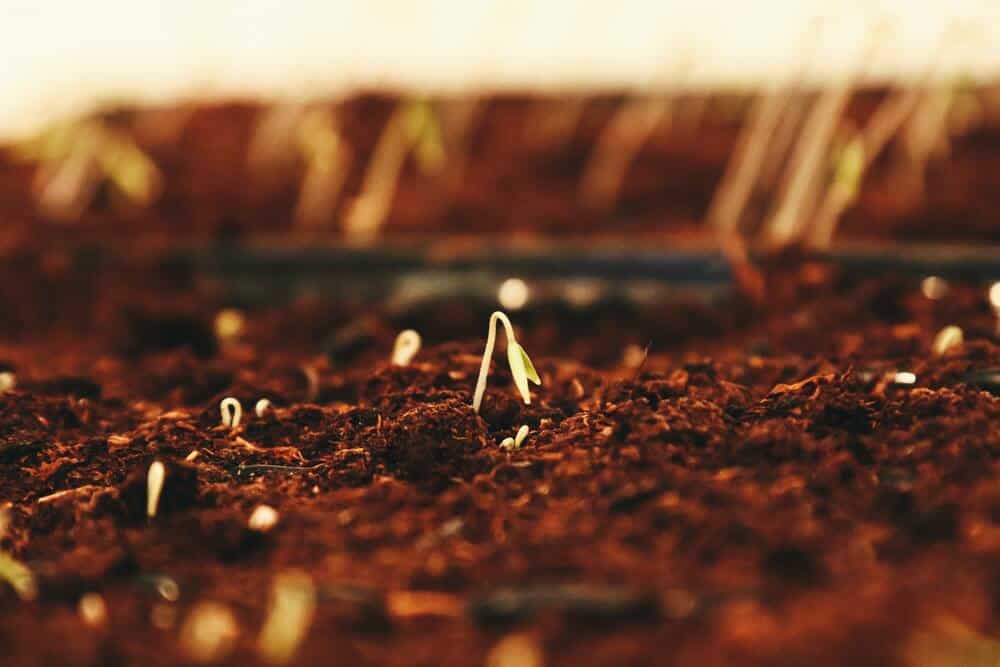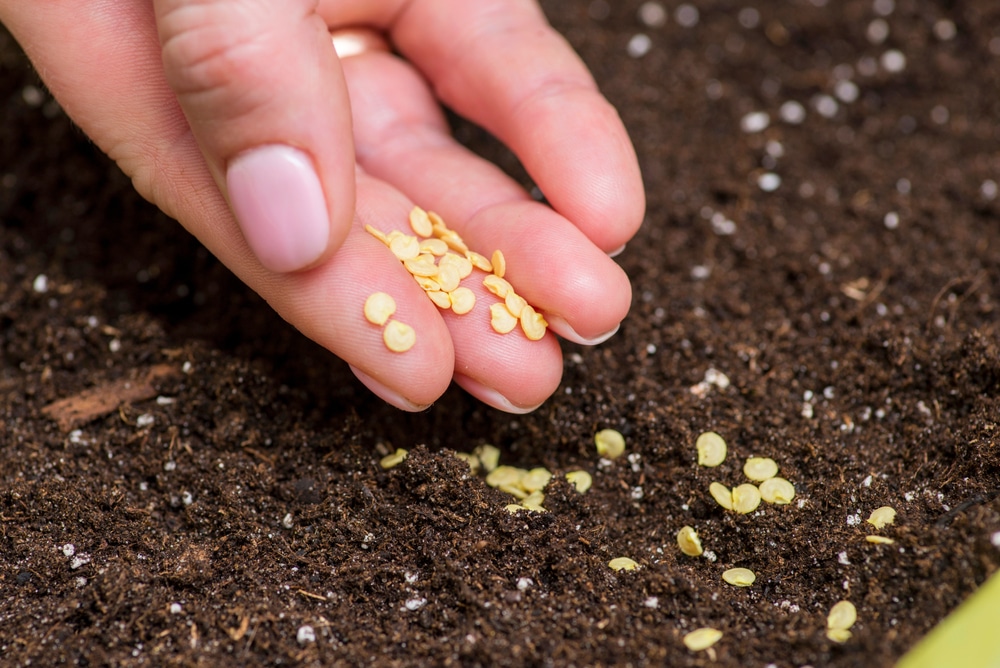
Many preservation methods can be used to manage plant seeds over the year.
A sealed container is usually all you need to manage the seeds over an extended period. However, if you don’t properly process the pepper seeds before preserving them in a container, there is a good chance that the pepper seeds might catch a disease.
How To Save Pepper Seeds for Planting Next Year?
With that said, many people have been asking how to save pepper seeds for planting next year. If you need help with what method to use, the following steps should help you with a complete picture.
- It would help to start by picking the perfect peppers for planting next year. Make sure the pepper you choose is intact and in good condition. That way, you can secure high-quality seeds that will ensure a solid germination rate.
- After picking the perfect peppers, wear gloves and remove the bottom of the pepper. Make a clean cut, and then push the seeds out of the opening you’ve just created.
- After pushing the excess seeds out of the peppers, you can use a knife to divide the pepper into two equal sections. Now, you’ll have complete access to the seeds attached to the pepper.
- Remove all the seeds from the pepper and spread them on paper. Make sure that there is enough air and less humidity to dry out the seeds properly.
- Once the seeds have been dried completely, you can manage the preservation process better. Just grab a clean container and use plastic food packers to dry the seeds. Then you can create a tight seal and leave your seeds in the basement.
If you’ve followed all these methods accurately, you won’t have to bother with diseases or bad germination rates. It will be effortless to manage the pepper supply next year because of the phenomenal germination rate brought by dried pepper seeds.
If you’re inexperienced, reading a gardening book or asking a local expert is one of your top options. There is no need to hesitate when unaware of different drying or sealing methods. So, make sure to reach out, and you’ll learn many effective techniques for managing pepper.
A good rule of thumb while picking out the seeds is that you should only use seeds from a plant with good health. Similarly, a diseased plant will also lead to many issues when you try to plant these seeds in the next year. So, make sure only to pick the peppers in perfect condition.
That way, you can pick many strong and healthy seeds that will positively impact the germination rate. This information helps you save pepper seeds for planting the next year in your yard.
What to avoid when saving pepper seeds for next year?
If you’re a fan of growing peppers, saving pepper seeds for the next year is an excellent way to ensure you can enjoy your favorite varieties. However, there are some important steps to take to ensure that your saved pepper seeds will still be viable.
Pick Healthy Seeds
You must select healthy peppers with no signs of disease or damage when harvesting them for seed saving. If any of your chosen fruits have spots, lesions, or other indications of poor health, discard them immediately and find healthier specimens instead.
Avoid Hybrid Seeds
It’s best not to save hybrid pepper seeds since they may produce unpredictable results when replanted in the future.
Follow the proper drying Method.
Once harvested from ripe fruits, the pepper seeds must be dried thoroughly before storing them later.
To do this properly, spread out the individual seeds on a paper towel and allow them to dry at room temperature until their surfaces become brittle and hard-like—this usually takes about two weeks, depending on environmental conditions like humidity levels.
Once fully dry, place each type of seed into its envelope or container labeled with its variety name before storing it in a cool dark location such as a cupboard or refrigerator.
Store Properly
When storing pepper seeds, it’s important to ensure the environment is cool and dry to avoid any fungal growth or other damage. If you plan on saving your pepper seeds for more than one season, check them periodically and discard any damaged ones.
These are the main points to remember when saving pepper seeds for future use. By following these simple steps, you can have a successful experience and ensure that your peppers will still be viable and ready to grow next season.
How to reuse pepper seeds from last year?
Reusing pepper seeds from last year can provide a great opportunity for novice and experienced gardeners to save time and money while growing their peppers.
Pepper plants are fairly easy to propagate, but if you’re looking to maximize your yield, there are a few things that you should consider before attempting to reuse roasted pepper seeds.
You’ll need to determine the optimal time to start your pepper plants. Depending on where you live, early spring may be the ideal time for planting peppers from seed.
Ideally, it would help if you started your seeds indoors about six weeks before the last frost date in your area. This will give them enough time to become established and ready for transplanting later.
Once you have established the ideal time for planting, you will need to clean and prepare your seeds for germination.
This process can be done by soaking them overnight in lukewarm water or using a seed starting mix. After the seeds are cleaned and prepared, they should be planted into small pots or containers and kept at a warm temperature (around 70-80 degrees Fahrenheit) with plenty of light.
You should monitor the moisture level in your soil and adjust accordingly. Too much moisture can lead to fungal diseases or seed rot; too little can cause the seeds to dry out before they can germinate properly.
When the seedlings appear, thin them out and give each remaining plant enough space to spread out.
After you’ve transplanted your pepper plants outdoors, remember to keep an eye on the temperature to ensure optimal growth.
Peppers prefer warm temperatures (70-85 degrees Fahrenheit), encouraging maximum fruit production. Make sure to keep them watered regularly and fertilize them every few weeks.
You should harvest your peppers when they are fully mature. Peppers harvested too early will not be as sweet or flavorful; those left on the plant for too long will become mushy and blemished.
Once you have harvested your peppers, you can save the seeds for next year’s crop. Simply dry the seeds out and store them in an airtight container until it’s time to plant again.
Reusing pepper seeds from last year is a great way to jump-start your garden and maximize your yield of flavorful peppers. With careful planning and consideration, your peppers will thrive in no time.
What’s the longest you can store pepper seeds?
Pepper seeds are popular for gardeners looking to grow their own peppers. But how long can you store pepper seeds before they become unusable? The answer depends on the type of pepper seed and the storage method used.
Most pepper seeds should last up to six months for short-term storage if stored in airtight containers and kept at room temperature.
If you want your pepper seeds to stay viable longer than that, it’s best to freeze them or keep them in a cool, dark place such as a refrigerator or root cellar. This will help significantly extend your pepper seeds’ shelf life—upwards of five years!
When storing your pepper seeds, ensure they are completely dry before placing them in an airtight container. Moisture is one of the biggest enemies when keeping peppers viable for longer.
Also, be aware that some types of peppers may not last as long as others; hot peppers tend to lose viability faster than sweet peppers, so be sure to carefully check expiration dates on packages when purchasing new seed varieties.
Concluding Thoughts:
In conclusion, pepper seeds are an excellent choice for gardeners looking to grow their peppers. With proper cleaning and preparation, these seeds can be stored for up to five years in an airtight container and placed in a cool, dark place such as a refrigerator or root cellar.
It is important to remember that some peppers have a shorter shelf life and can become unusable after six months of storage if not kept at the right temperature.
Finally, keep your pepper seeds completely dry before putting them into an airtight container to ensure maximum viability. With these few simple tips in mind, you can harvest delicious peppers for years to come!



